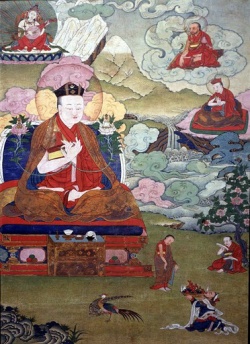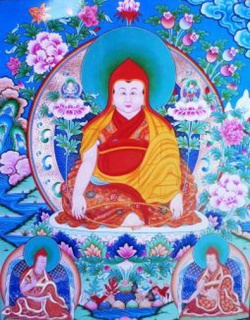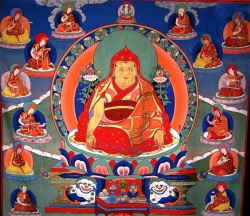Rangjung Dorje, the 3rd Karmapa, on Ordinary Awareness and Pristine Awareness…
I find this treatise by the 3rd Karmapa, Rangjung Dorje, very clear and expressive in its description of the view as it relates to the nature of the qualities of our awareness. It is also an excellent example of the depth of experience that Rangjung Dorje established and familiarized within himself.
As is pointed out in the first footnote to the translation, this text presents the shengtong view (emptiness of other) as it relates to the emptiness of mind/phenomena. This view, while similar to aspects of the Yogachara approach as laid out by Asanga and Maitreya, is a Madhyamaka (middle way) view. The central point of orientation of the shengtong view is that while the mind is empty of any inherent self-nature, there is a quality of luminosity, the infinite Bhuddha-nature quality that is innate to the mind. Some claim that a view like this is eternalist, and therefore incorrect as it suggests that since there is some kind of quality that the mind has, it cannot therefore be empty of inherent self-nature. This is the rangtong view; it is a view in which the mind is found to lack any particular nature or inherent characteristics.
While there is currently, and has been in the past, a great deal of debate around this matter (to put it mildly), perhaps these two perspectives are two sides of the same coin. The rangtong view, simple and bare bones, seems to suggest the general theory of the Madhyamaka school, for lack of a better word. It might be posited that the shengtong view arose, and still has currency through and around the experience of meditation, especially buddhist tantric meditation. Indeed, I wonder what Nagarjuna would have to say about this. Perhaps they are appropriate, or more instructive at different times and in different ways. These two brilliant experiences are rich and offer us a great deal.
While I am not very skilled in dialectical reasoning, I am happy to leave the debate as to who is correct, the shengtonpas or the rangtongpas, to others. But, I would like to point out that I feel that it should be noted that while the shengtong view is of central primacy for the Jonang lineage, it is also of great importance within the Kagyu and Nyingma lineages. In fact, there appears to be lot of symmetrical terminology between the shengtonpa view and the language that is used within the Kagyu tantric completion stage practices (Six yogas of Naropa/Niguma and Mahamudra) as well as that of the Nyingma lineage (as found in the practice of Dzogchen). I think that there is something to this. Perhaps this relates to the language of the shengtong position in relationship to the direct experience the mind’s essential nature. It is a position of intimacy; a view that evokes the entirety of the range of the way that mind arises. It is full, but not overly reductive, as the rangtong position sometimes feels.
Jamgon Kongtrul Lodro Thaye was instrumental in bringing much of the shengtong view back into the Kagyu lineage. This continued through the previous Kyabje Kalu Rinpoche, and especially the late Kyabje Bokar Rinpoche, who was a holder of the Jonangpa Kalachakra lineage, an important source of the shengtong view that was exemplified by the great Dolpopa Sherab Gyaltsen (1292-1361), the great meditator and teacher who is credited with founding the Jonangpa Lineage. In fact Dolpopa and Rangjung Dorje were contemporaries and spent time together.
This particular text was translated by Michael R. Sheehy, Director of the Jonang Foundation, Senior Editor at the Tibetan Buddhist Resource Center, and Lecturer of Buddhism and Tibetan Language at the New School here in New York.
As today is Saga Dawa, I wholeheartedly invite you to explore this text, and I pray that it adds clarity, depth, and confidence to our practice.
May it bring you benefit! And may you bring the pacification of others’ suffering!
Ordinary Awareness & Pristine Awareness:
A Treatise on the Distinction
Composed by the 3rd Karmapa Rangjung Dorje (1284-1339)
To all of the buddhas and bodhisattvas, I pay homage!1
Having thoroughly relied upon learning and reflecting,
I’ve resided in secluded places in order to apply the methods of meditation. In accord with these means, I’ll now describe my experience to you.
Some people think that the triple world and all living beings arose from itself, from others, from both, or without any cause.
Others say that one’s own self and the world are generated from a creator god such as Cha, Śiva, Brahmā or Viṣṇu, from an external particle, or from a truly existing hidden substance.2
As the sole omniscient one taught, the three worlds are merely the mind.3
They are not derived from themselves, from something else, from both of these, or without a cause—all phenomena arise interdependently.
They are by their own essence empty, devoid of features that are distinct or unique, and
free from features of truth or falsity—like a magical illusion, the moon in water, and so
forth…
Knowing this, the Buddha taught to sentient beings.
In this way, from what source does so-called “delusion” and “non-delusion” arise? Having relied upon the nature of interdependent co-origination, I have come to know this like my own image in a mirror, like fire from smoke. Here, I’ll clearly describe to you my realization.
Ordinary conscious awareness of the five sense entrances,4
By having accepted and rejected forms, sounds, smells, tastes, and textures have generated emotional upset.
So, what are these so-called “sensible objects?”
If the wise were to carefully examine, they would not be able to establish the existence of anything external such as atoms and so forth, as other than one’s own discerning cognitive awareness.5
If the substances of sensible objects were simultaneously different than conscious awareness, then they would not have the same nature.
Because inert material substances do not arise from indivisible immaterial cognition, their arising is not related.
By accepting that sensible objects are different than awareness, it is illogical to think that sensible objects would appear from cognitive awareness.
Because of this, whatever appears is not a sensory object different than awareness.
The occurrence of these objects is similar to the experience of conscious self-reflection.6
In fact, even the appearances of minute indivisible particles and vast openness are mind.
Since their existence cannot be established externally or separately,
The realization is that creators such as Brahmā and other such creator gods do not exist.
Furthermore, the relationship between one’s mental awareness and phenomena are similar to the experience of a dream.7
This is to say, this relationship is consumed by the mind fixating onto referents that have no true reality.
Likewise, the six modes of ordinary perceptual awareness,8 the appearances of exterior referents and living beings, self-importance, cognitive discernment, and whatever manifestations appear,
Are not produced from anything else,
They are not produced from themselves,
They are not produced from both themselves and something else,
And they are not produced from the absence of themselves and something else.
In the same way, the victorious one taught that everything within saṃsāra and nirvāṇa is merely the mind.
Causes, conditions, and dependent co-origination were taught by the Buddha to be the six modes of ordinary perceptual awareness, tainted mental awareness, and the universal ground as ordinary awareness.9
The six modes of ordinary perceptual awareness are reliant upon the objective conditions of the six sensible objects of form and so forth.
The predominant condition is the six sensory faculties. They are lucidity endowed with form.
Both sense faculties and their objects arise from the mind.
The total manifestation of sense faculties and their objects rely upon sense bases that are without an inception.
Although ordinary awareness perceives objective referents,
It is the conceptualizing mental factor that cognizes their distinctive qualities.10
Mental awareness relies upon both immediate and tainted mental awareness.11
Because immediate mental awareness is the condition for the generation and dissipation of the six modes of ordinary perceptual awareness,
This is in congruence and accordance with the frequency of the instantaneous generation and dissipation of the six modes of ordinary perceptual awareness.
This is known by a mind imbued with yoga, and through the teachings of the victor.
Within the mind itself, there is an aspect of this immediate mental awareness that is said to be “mental awareness endowed with tainted emotionality” because, due to the transitory nature of the constituents of embodied experience,
It fixates onto an egocentric attitude, conceitedness, and self-infatuation while infused with ignorance.
Immediate mental awareness dissipates the six modes of ordinary perceptual awareness, and is the source from which consciousness arises.
Tainted mental awareness then becomes the source for emotional upset.
For these reasons, mental awareness has two facets: it possesses the capacity to both create and obscure.
To those with particularly refined intelligence, the Buddha taught the universal ground as ordinary awareness.
This is also referred to as the “foundation for ordinary awareness,” the “source for ordinary awareness” and the “receptacle for ordinary awareness.”
Within it, all of the latent propensities generated by the seven modes of ordinary awareness are accumulated distinctively and neutrally—like rainwater flowing into the ocean.
This is why it is called, “ripening awareness.”
Because it generates everything, and is the ground from which all seeds emerge, it is referred to as the “causal condition.”
Nevertheless, since it is reversed when the seven modes of ordinary awareness are inverted, it is also known as “conditional ordinary awareness.”
This universal ground as ordinary awareness is the embodiment of everything external and internal, the source of all that is to be relinquished.
So, it is said that it can be subdued through “vajra-like meditative stabilization.”
When the universal ground as ordinary awareness along with its defilements is reversed, there is mirror-like pristine awareness.
Every mode of pristine awareness appears without identifying with a substantial self, they are continuous and utterly without interruption.
Because this realizes what can be known with a reference,
And because this is the reason for every type of pristine awareness,
This is referred to as the “ultimate dimension of phenomena.”12
The emotionally tainted mental awareness is totally subjugated by the “meditative
stabilization of courageous movement.”
Disturbing emotions are entirely relinquished through insight and meditative cultivation.
Once upsetting emotions are absent, saṃsāric existence and nirvāṇic quiescence cease. This is the pristine awareness of equanimity.
Immediate mental awareness apprehends by seizing onto the six modes of ordinary perceptual awareness.
Its discursive thinking is produced by conceptualization,
And its perfect discernment subdues through “illusion-like meditative stabilization.”
When great patience is acquired though transforming apprehensions and their objective references, pure realms are revealed.
Ever-pervasive pristine awareness and unimpeded pervasive activities thoroughly transform the source of thoughts into the pristine awareness of discernment.
In this way, these two types of pristine awareness—equanimity & discernment—through pure meditation, do not abide within saṃsāric existence and nirvāṇic quiescence.
Imbued with tranquility, love, and compassion while encompassed within the surrounds of retinues and multifarious dimensions of enlightenment, they express the utterances of
buddhas.
The melodious maṇḍala of the magnificent teachings resounds within the treasury of every profound meditative absorption and mystical formulation.
This is referred to as the “dimension of complete resplendence.”13
The five sense entrances and mental awareness are a single quality.
Through perfect analysis, there arises the way of the four truths endowed with their differing aspects, the sixteen wisdoms of knowing, acceptance, and so forth.
Sensible objects are perceived directly and their actuality is realized.
The five sense faculties are transformed when there is engagement with all of their corresponding sensible objects, and the qualitative attributes of everything is magnified twelve-hundred-fold through the power of magnetizing.
This is the final accomplishment, all-accomplishing pristine awareness.
That which through innumerable and inconceivable manifestations of every variety, at all times, within every realm of existence, will accomplish benefit for every being is known as the magnificent “emanatory dimension.”14
Mind, mental awareness, and ordinary perceptual awareness are transformed into the three enlightened dimensions imbued with their activities;
Complete within the uncontrived maṇḍala of the ultimate sphere of phenomena.
All things reside without saṃsāra or nirvāṇa or their inceptions—free from singularity of diversity.
This is referred to as the “essential dimension.”15
In other scriptures by the victorious one, this is taught to be the “ultimate dimension.”
The mirror-like pristine awareness is regarded as the embodied dimension of pristine awareness, and the other types of pristine awareness are said to be the two enlightened form dimensions.16
Buddhahood is actualizing the nature of the five types of pristine awareness and the four enlightened dimensions.
What is embellished by the distortions of the mind, mental awareness, and ordinary perceptual awareness is the universal ground as ordinary awareness.
What is free from distortion is described as, “the essence of the victorious ones.”
The Buddha taught that the truth of the spiritual journey is seizing onto the capacity of the discerning wisdom of the exalted ones that arises from sublime conceptualization, and that quells profane conceptualizations.
By not understanding this way of the ultimate,
The delusional stray about within the ocean of saṃsāra.
By not understanding this Mahāyāna vessel, and without transforming yourself, How could you ever cross to the far-off shore?
May everyone realize the meaning of this treatise!
“Ordinary Awareness and Pristine Awareness: A Treatise on the Distinction” was composed on the 1st day of the 10th lunar month of the year of the swine (1323) in the mountain hermitage called, “Dechen Teng” [“The Aperture of Bliss”] by Rangjung Dorje.
Translated by Michael R. Sheehy, Ph.D.
Notes
1 This work by the 3rd Karmapa Rangjung Dorje is included here in Jonang Foundation’s Digital Library because it reflects a view that has been characterized as ”zhentong” (gzhan stong) by later Tibetan authors, most notably Jamgön Kongtul (1813-99), see Mathes (2004), 288-94. Rangjung Dorje was a contemporary of Dolpopa and they met to discuss such views on at least one occasion, see Stearns (1999), 17.
2 Cha (phyva) literally means “luck” or “fortune.” Here it refers to an ancient pre-Buddhist Bönpo belief about the creator of the world. In this conception, “Cha” is the reason for all eventual prosperity. These are references to the theistic tendency to rely on an external force. For a closer study of this text with Jamgön Kongtul’s commentary, see Sheehy (2005).
3 This is a reference to cittamātra (sems tsam).
4 The five sense entrances (sgo lnga) are:
(1) eyes;
(2) ears;
(3) nose;
(4) mouth;
(5) body.
5 The term here is: rnam rig shes pa.
6 The term here is: rang rig. This is a term that denotes the capacity of awareness to know itself or be selfaware.
7 The term here is: yid (manas). This is referring to the conceptual or ideational operations of cognitive awareness.
8 The six modes of ordinary perceptual awareness (tshogs drug) are:
(1) visual perceptual awareness;
(2) auditory perceptual awareness;
(3) olfactory perceptual awareness;
(4) gustatory perceptual awareness; (5) tactile perceptual awareness.
9 The terms here are: nyon yid ki rnam shes and kun gzhi rnam shes
10 Here it reads, sems byung ‘du byed while an alternative reading is sems byung ‘du shes. See Rang byung (2002), n. 20.
11 The term here is: ma thag dang nyon yid. This refers to the four conditions (rkyen bzhi) that preserve the continuity (rang rgyud) of cognitive awareness through immediate subsequent experiential moments of conscious experience. The term: ‘jig tshogs here refers to a composite of many elements of the skandhas that is destroyed instant by instant. Skandhas are the psychophysical constituents that comprise ordinary embodied experience.
12 The term here is: dharmakāya, chos sku.
13 The term here is: sambhogakāya, longs spyod rdzogs sku.
14 The term here is: nirmāṇakāya, sprul sku.
15 The term here is: svabhāvakāya, ngo bo nyid sku
16 This is a reference to: nirmāṇakāya and sambhogakāya.
Tibetan Sources
Kong sprul Blo gros mtha’ yas, ‘Jam mgon. Rnam par shes pa dang ye shes ‘byed pa’i
bstan bcos kyi tshig don go gsal du ‘grel pa rang byung dgongs pa’i rgyan ces bya ba. Sikkim: Rum btegs, 1972.
Mkha’ khyab Rdo rje, The 15th Karmapa. Rnam par shes pa dang ye shes ‘byed pa’i bstan bcos kyi mchan ‘grel rje btsun ‘jam pa’i dbyangs ki zhal lung nor bu ke ta ka dri ma med pa’i ‘od. In Three Important Verse Treatises on Aspects of Mahāyāna and Vajrayāna Buddhism: By H.H. the 3rd Karma-pa Ran-byung-rdo-rje, with Annotations Expanding the Text (mchan) by H.H. the 15th Karma-pa Mkha-khyab-rdo-rje. New Delhi: Delhi Karmapae Chodhey Gyalwae Sungrab Partun Khang, 1976.
Rang byung Rdo rje, The 3rd Karmapa. Rnam shes ye shes ‘byed pa’i bstan bcos. Sikkim:
Rum btegs, 1972.
__________. Rnam shes ye shes ‘byed pa dang de bzhin gshegs pa’i snying po bstan pai bstan bcos zhes bya ba. Kathmandu, Boudha: Dharma Kara Publications, 2002.
Western Sources
Mathes, Klaus-Dieter. “Tāranātha’s ‘Twenty-one Differences with Regard to the Profound Meaning’—Comparing the Views of the Two Gźan stoṅ Masters Dol po pa and Śākya Mchog ldan.” Journal of the International Association of Buddhist Studies, 27, 2, 285-328, 2004.
Sheehy, Michael R. “Rangjung Dorje’s Variegations of Mind: Ordinary Awareness and Pristine Awareness in Tibetan Buddhist Literature.” In D.K. Nauriyal (ed.).
Routeledge Curzon’s Critical Series in Buddhism. Buddhist Thought & Applied Psychological Research. London: Routledge Curzon Press, 2005.
Stearns, Cyrus R. The Buddha from Dolpo: A Study of the Life and Thought of the Tibetan Master Dolpopa Sherab Gyaltsan. New York: State University of New York Press, 1999.
© 2007 Michael R Sheehy.
Courtesy of the Ngedon Thartuk Translation Initiative


